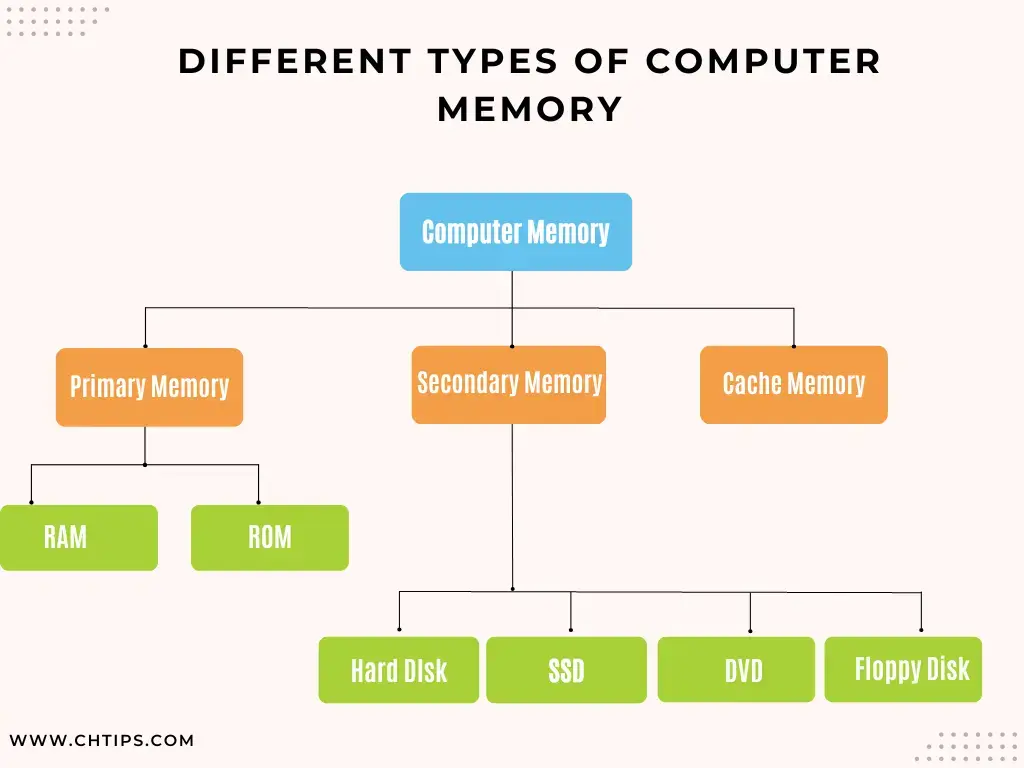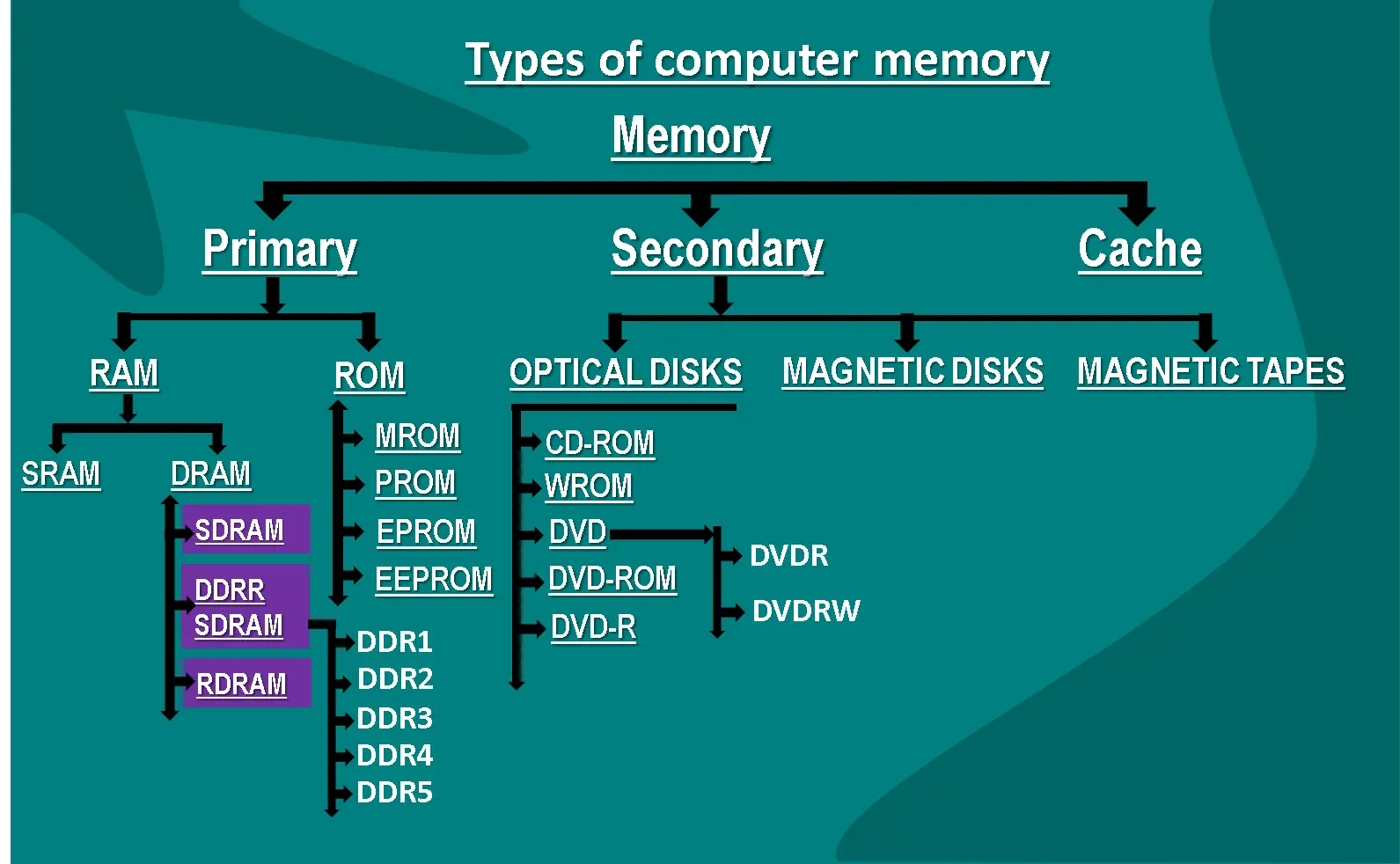Types of Computer Memory
Computer memory is vital for storing data and running programs on a computer. There are several different types of computer memory that serve different purposes. Understanding the different types of memory can help you better understand how your computer works. This article provides an overview of the most common types of computer memory.
What is Memory?
Memory refers to computer components and recording media that retain digital data used in Computing for some interval of time. Computer memory operates at a high speed, for example random access memory (RAM), unlike storage that provides slow-to-access data storage but offers higher capacities.
How Does Memory Work?
Computer memory stores data temporarily or permanently by using electronic circuits consisting of semiconductor devices. Data remains in volatile memory as long as the computer has power, while nonvolatile memory retains data even when the computer is turned off. When a program needs to access stored data, it sends a request to the memory controller, which retrieves the data and transfers it to the processor for use.
Different Types of Computer Memory
There are two main types of computer memory: random access memory (RAM) and read-only memory (ROM). RAM and ROM memory different in terms of how data is stored, accessed and retained. There are also different variations of these two main types of memory.

RAM (Random Access Memory)
RAM allows data to be accessed randomly at high speeds. It is considered volatile memory since data in RAM is lost when the computer is turned off. The different types of RAM include:
Dynamic RAM
Uses capacitors and transistors storing bits as electric charge. Needs to be refreshed thousands of times per second. Used for most system memory.
Static RAM
Uses a flip-flop circuit to hold bits. Faster and less power-hungry than dynamic RAM but much more expensive. Used for CPU cache memory.
Double Data Rate SDRAM
Synchronizes data transfer with bus clock ticks making transfers twice per clock cycle. Provides faster data transfer than regular SDRAM.
DDR4 Synchronous Dynamic RAM
Latest SDRAM version, DDR4 offers higher module density and bandwidth compared to predecessor DDR3. Operates at 1.2 volts.
Rambus Dynamic RAM
Proprietary type of DRAM memory that can transfer data quicker. Used in high bandwidth applications.
ROM (Read Only Memory)
ROM contains permanent or semi-permanent data that can only be read, not written to. The data is non-volatile and remains even if computer lost power. Types of ROM include:
Programmable ROM (PROM)
Can only be written to once using special PROM programmer device. Used to store permanent programs like firmware or BIOS.
Erasable PROM (EPROM)
Can erase contents by exposing the memory chip to UV light. Chip then can be reprogrammed.
Electrically Erasable PROM (EEPROM)
Allows individual memory locations to be erased and reprogrammed electrically, without removing the chip from the computer. Used for storing firmware, BIOS settings etc.
Virtual Memory
Uses hard disk space to simulate additional RAM memory. Pages of inactive virtual memory swapped to disk, and back when needed by programs. Allows more memory space than physically available.
Secondary Memory/Storage
Refers to external storage devices used to store data permanently or long-term. Does not lose data when computer turned off. Includes:
Cache Memory
Small amount of fast memory located close to CPU holding most frequently used data to speed up access.
Hard Disk Drives
Non-volatile, random access storage device containing spinning disks coated with material that stores data magnetically.
Compact Discs (CDs)
Optical disc storage medium that stores digital data. CD-ROMs contain pre-recorded read-only data.
Pen Drives
Small removable flash memory devices connected via USB port. Also called USB drives.
Now, understanding this concept is simple and entertaining for Hasons. Using the Hason website you can always stay one step ahead in your job, business, or studies by purchasing New Age Desktops and All in One Desktops, i3 Intel Core Processor Desktop starting from 15000/-. Monitors, CPUs, and Gaming Desktop are also available. Register on Hasons and order your Tech Partner Now. Get exciting offeNrs and benefits on your every purchase. Contact us so our support team can guide you in purchasing the right Technology Partner.
SSD 512 AIO Desktop Of HASONS With Processor Gen I3 12100, Chipset Series Q670, Windows 10 Pro, 512 SSD, DDR4-8GB, Wired Keyboard & Mouse, Black Screen 23.8
SHOP NOW
Benefits and Importance of Different Types of Computer Memory
The various kinds of computer memory serve vital roles in computer operation:

- Enables computers to run multiple processes simultaneously
- Allows quick access to running programs and associated files/data
- Fast memory like cache/RAM enables smooth program and file execution
- ROM safely stores low-level firmware programs like BIOS securely.
- Secondary storage offers vast capacities for long term data storage
- Virtual memory effectively expands usable memory capacity
Having the right combination of memory types enables personal computers and other devices to operate efficiently at optimal speeds. Understanding memory functionality assists in troubleshooting computer problems.
Conclusion
computer memory consists of primary storage hardware components and recording media which temporarily or permanently retain information used in computing devices. The primary categories of computer memory are volatile random access memory, non-volatile read-only memory, and secondary storage devices. These different memory types work synergistically to store operating system files, program code and user data which enables modern computing as we know it.
| For updates in the Types Of Computer Memory, read Hasons Blogs. Some of them are as follows: | ||
| Types of CPU Cooler | Application of GPS | |
Types of Computer Memory

